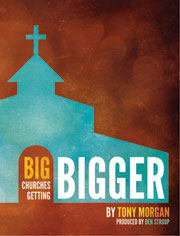By Rez Gopez-Sindac
 In the United States, there are 1,800 megachurches – those averaging 2,000 or more in weekly worship attendance – according to church lists compiled by Leadership Network. A 2011 study of 336 megachurches conducted by Leadership Network and Hartford Institute for Religion Research shows that “megachurches remain one of the most robust religious organizational expressions within North America … with these churches averaging 8 percent growth per year for the last five years.”
In the United States, there are 1,800 megachurches – those averaging 2,000 or more in weekly worship attendance – according to church lists compiled by Leadership Network. A 2011 study of 336 megachurches conducted by Leadership Network and Hartford Institute for Religion Research shows that “megachurches remain one of the most robust religious organizational expressions within North America … with these churches averaging 8 percent growth per year for the last five years.”
Tony Morgan, pastor of ministries at West Ridge Church near Atlanta and author of several books, including the e-book Big Churches Getting Bigger, says large churches continue to grow and thrive because “they are strategic in their approach to alignment, adaptability, leadership, and reach.”
Morgan explains these four factors in his e-book (available at TonyMorganLive.com/book) and shares with Church Executive some proven strategies to church growth and health.
What’s the biggest fear large churches have to overcome to continue growing? I think the biggest fear to overcome is the fear of losing control. If you feel like you have to control people and systems, that’s the moment you begin to die as an organization.
Ironically, big churches tend to have fewer controls than smaller churches. Generally, they seem to have fewer rules, fewer committees and fewer meetings. That doesn’t mean it’s a free-for-all. It just means they’ve learned that they need to release people to be who God created them to be.
 What kind of leaders are effective in growing an already big church? Effective leaders in growing churches have learned to empower people. Real leaders have learned that ministry is bigger than preaching a message or singing a few songs or pulling off a great event. Real leaders empower people, using their God-given gifts, to engage ministry in the real world.
What kind of leaders are effective in growing an already big church? Effective leaders in growing churches have learned to empower people. Real leaders have learned that ministry is bigger than preaching a message or singing a few songs or pulling off a great event. Real leaders empower people, using their God-given gifts, to engage ministry in the real world.
You identified alignment as one factor that makes a church grow bigger and stronger. When does full alignment happens in a church. Alignment happens when a church not only clarifies its vision but also says, “This is the strategy we’re going to use to get that vision accomplished.” Many churches haven’t landed on a strategy. Because they’ve never done that, people are either left guessing what they’re supposed to do to support the vision or, worse yet, people start establishing their own strategies based on previous church experiences. Without unity, there will never be health and growth.
Give an example of where a method is more important to a church than its mission. One of my favorite stories that Mark Beeson, the senior pastor at Granger Community Church, tells is about a church that used to sell peanut brittle to raise money. One year as the annual sale approached, there was an argument over which peanut brittle recipe they should use. The church ended up splitting because they couldn’t agree on a recipe. Needless to say, they lost sight of the church’s mission. Any time our methods get in the way of our mission, we might as well be arguing about peanut brittle recipes.
What could lead to the demise of a big church? What are its vulnerabilities? My biggest concern for big churches is the issue of leadership development. There seems to be a lot of talk about leadership but not much leadership development is actually happening. For me, leadership development and mentoring and discipleship all blend together. We’ve stopped thinking in those terms. Instead, the focus is on transferring knowledge through services and events. That approach will not develop leaders. Because of that, I think the leadership transitions we’ll see in large churches in the coming decade will be very interesting to watch.


